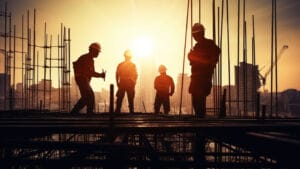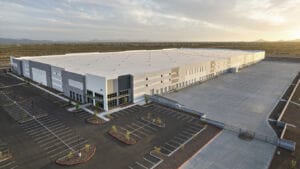Valley Partnership is celebrating 25 years as Metro Phoenix’s premier advocacy group for responsible development. In looking back – and also looking ahead – AZRE magazine brought together six former chairmen to discuss goals the group has successfully achieved and challenges that lie ahead.
With the commercial real estate industry making a slow recovery from the Great Recession, the advocacy role undertaken by a group such as Valley Partnership is magnified. “The surge in commercial real estate is evident,” says Richard Hubbard, president and CEO of Valley Partnership. “The comments from our past chairs provide great direction to Valley Partnership for the next several years. “With the increasing activity, it is imperative we re-energize our advocacy efforts with particular focus on the local communities while always monitoring our state and federal governments for any issue that affects our industry.” Participating were John Graham (JG), Sunbelt Holdings, chairman in 1989; Dave Scholl (DS), Westcor-Vintage Partners, chairman in 1990; Clesson Hill (CH), Grayhawk Development, chairman in 1997 and 1998; Jim Pederson (JP), The Pederson Group, chairman in 1999; Pete Bolton (PB), CBRE/Grubb & Ellis (Newmark Grubb Knight Frank), chairman in 2004; and Charley Freericks (CF), DMB Associates, chairman in 2006. Rick Hearn (RH) of Vestar, the current chairman, served as moderator.
RH: During the past 25 years, has the level of economic development undertaken by local governments and the state been inadequate, adequate or exceptional?
PB: Frankly it’s all three. Over the years, it’s been inadequate, and it’s gone to adequate, and then I think in some cases it’s been exceptional. It also depends on which state we compare ourselves with because some states are exceptional and then some states are just barely adequate. And then you can go in the opposite direction, say inadequate, compared to Texas, and some of the other big ones across the country. Overall, we are doing a better job today.
CH: I would agree. I think there is lack of funding these days and I think that education has suffered greatly and that is a major infrastructure that needs to be rebuilt. Not just here but everywhere, and as we move forward and embrace new technology, it is a new way of life as we look toward the future.
DS: When I looked at this question, I really focused on the side of economic development and “are cities making investments?” I think that a lot of ways the cities have been trying to operate with their arm tied behind their backs. The constitution and our legislators have never really given our local government a whole lot of choices in their tool boxes. With the limited tools they have in there, they have done a pretty good job. I think that the industry I have been in has had a lot of city participation in economic development, and I think that they have been pretty aggressive about getting the most out of what limited tools the state’s constitutional statues have given.
RH: Charley, your company was impacted by this exact thing at Eastmark (in Mesa) in regard to Apple. What are your thoughts?
CF: Well it was not just Apple. It happened to us positively with First Solar. We were able to compete and win there. And with Apple, to be in the mix, I’m where Pete was. It is an evolution where economic development has come a long way since 1987. I had to think about 25 years, and I didn’t know I had been in the business that long. I look at what has happened now as the communication level of real prospects is very high and people know they’re coming and looking, which in the old days you would hear about it and it was here and gone. I’ve been in that side of the business almost my entire career chasing prospects from out of state. We come in second place to states that want to write checks. When we lose, we lose because somebody wrote a check and throws money at it to the prospect. I’ve never been a huge advocate at writing big checks. It’s a complicated business. I think we are doing a lot better chasing these deals and being in the running and again the tool kit is very limited.
JG: I’m actually optimistic about many things and this is actually one of them. My view is that being a young state one of the things that we did probably an amateurish job in early on was in economic development. I think that was a maturity problem not a “we didn’t quite get it problem.” With what we have now with GPEC and ACA and trying to address some of our structural and political and legislative problems, we got a really good pipeline of stuff that is being looked at and is being professionally handled.
JP: Certainly economic development depends on how you define it. A lot of people think that dangling a check in front of a major company is going to bring jobs into the state. But as Clesson mentioned, it’s more than that. It is infrastructure investment; it’s education and venture capital.
RH: Has Valley Partnership had a positive effect of creating a better image for developers?

JP: There is a word that has been overused but I think that it is applicable. In this case, that is sustainability — the sustainability of our communities. It directly relates to our industry because we plunk down projects, neighborhoods or communities, and we depend upon a standard of living that is directly dependent on the rents that we get for our properties. During recession times, construction prices go down, land prices go down, but you have to achieve the rents if you are going to be successful at the end of the day. What Valley Partnership has done, by emphasizing how development relates to a sustainable lifestyle in the various communities where we live, is to look more beyond the block of where you are developing. It’s looking at your community, looking at your neighborhood. Looking at the various infrastructure investments that are critical to the kinds of things we do. We manufacture a product. And to manufacture the product, you need certain things, at least in the shopping center business. You need good tools. You need quality neighborhoods. You need good infrastructure investments. All of those things that directly relate to the level of rents we are going to get. In that regard I think Valley Partnership over the past 20 years has been excellent. I think it’s an organization that has emphasized the sustainability concept.
JG: I think the short answer is yes, that is has improved the reputation of how people view the development industry. The other part of that is the role that Valley Partnership will never go away because inherently we are in a conflict relationship with neighborhoods and other people. No matter how good of a job we did, it’s always going to be viewed that way. I think we have changed the conversation from one that was always in essence an adversarial, to at least everyone understanding that it is a two- or three-legged stool at a minimum, and that things have to be done by more than consensus. It has to be more by partnership and good conversation. That is why Valley Partnership will always have a role to the extent of how we want to have it because no matter how good a job we do, we will have different rubs with different constituency groups. But I think the role we need to continue to take is being the group that is not adversarial, rather constructive in those conversations for solutions.
CF: I was more optimistic on this one. My immediate reaction was absolutely that my focus was on the government. As an industry dealing with all of the city, town and county issues for regulations of our industries locally, I think Valley Partnership’s reputation really had a big impact because we have rational and moderate voices coming through consistently saying, “Gee, your regulation here is either irresponsible or maybe needs a little tune-up or maybe you missed a big idea here.” So from the professionals within our industry that we deal with, staff level government in particular, I think our reputation over the past 20 years has improved radically. I’m with the other guys here. The challenge we face will always be in conflict with residents and neighborhoods, and we need to keep doing our jobs well to keep doing that and not be controversial.
DS: I agree. I think that whenever you look at an image, you have to talk about which audience you are talking about. I think among consumers or neighborhood groups and homeowners, I don’t know if they have enough regular engagement to really understand who Valley Partnership is. I don’t know if the developers’ image among the average fellow on the street has improved that much. I agree with Charley. I think we are front of mind when a city or a local government says, “We need input, or we are thinking about changing this part of our code.” I think we are one of the first people they think of to come to the table and have the dialogue; whereas before Valley Partnership, it was a very splintered industry, and I don’t think there was a common voice and more importantly a common set of ears that listened to cities when they needed have that dialogue, too. So I think it has been vastly improved.
PB: What Valley Partnership has really accomplished with the local municipalities is to provide them with a dependable, educated voice. I remember sitting on a board and something would come up and a local municipality would ask, “Can you guys put something together on this billboard issue?”, and we would have six very educated voices at the table later that afternoon. That just doesn’t happen in any other organization. From my side of the business (brokerage), that has been extremely positive. As soon as we get the local municipalities on board, which they are, the neighborhoods rarely follow, but they don’t have much depth of voice anymore because if the politicos are truly believing the intelligent voices of the marketplace, they have a tendency to be more objective.
CH: I think part of the sustainability of 25 years of leadership is that Valley Partnership has been able to maintain frontline guys and women who are involved in development and kept them passionate about Valley Partnership. It has never faded away or lost its image in the cities to know that if we come, we will get quality people stepping up and get engaged and deliver some kind of end product. I think it’s a tribute to the leadership inside Valley Partnership to maintain that constant level of quality people.
Continue reading this article.



